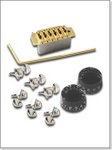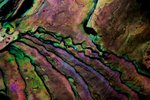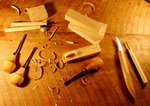
A few years ago I was approached by a fellow who had a Gibson Les Paul Recording Guitar which was a variation of the established model. Back in the early 1970s, Gibson began experimenting with new models such as the "Les Paul Recording." This model is often eschewed by guitar purists: considered too full of "gadgetry." The "Recording" featured low-impedance pickups, many switches and buttons, and a highly specialized cable for impedance-matching to the amplifier.
The instrument I received had a badly damaged finish. At one time someone had modified the instrument by removing the low impedance pickups and replaced them with traditional humbuckers. This entailed filling the original pickup cavities and re-routing new ones appropriate for the humbuckers.
As the instrument had no value in the condition that it was in, I proceeded to make it both playable and ascetically pleasing.
Below are a few of the steps in the progression of the rebuild.

 Body spray painted with gloss black water based Hydrocote brand finish. Clearcoat Hydrocote sprayed as topcoat. Finish is "rubbed out" using a variety of abrasives from 'Micromesh' cloth to powdered abrasives such as Pumice and Rottenstone in water or paraffin oil. Final gloss is achieved with Meguier brand automotive finish compounds.
Body spray painted with gloss black water based Hydrocote brand finish. Clearcoat Hydrocote sprayed as topcoat. Finish is "rubbed out" using a variety of abrasives from 'Micromesh' cloth to powdered abrasives such as Pumice and Rottenstone in water or paraffin oil. Final gloss is achieved with Meguier brand automotive finish compounds. Making sure hardware fits. Caution! A nice tight fit may be reduced in size due to the thickness of the finish used.
Making sure hardware fits. Caution! A nice tight fit may be reduced in size due to the thickness of the finish used. New White binding attached to channel on guitar edge with Acetone based plastic cement.
New White binding attached to channel on guitar edge with Acetone based plastic cement.
Binding secured with tape while glue dries. Fret removal using soldering iron and pliers.
Fret removal using soldering iron and pliers.
(Heat softens old glue and lessens wood chipping during removal) Frets cut to size and ends of frets are "nipped" using special tool.
Frets cut to size and ends of frets are "nipped" using special tool.
Nipped ends of frets allow frets to run over binding without passing through them. Copper shielding glued into all electronics cavities to reduce extraneous electronic interference. Alternatively a metal particle paint can be used.
Copper shielding glued into all electronics cavities to reduce extraneous electronic interference. Alternatively a metal particle paint can be used.
(extra contact cement ensures sticky copper back will adhere) Potentiometers (Volume & Tone) & Selector Switch with Output Jack on underside of copper shielded control cavity cover.
Potentiometers (Volume & Tone) & Selector Switch with Output Jack on underside of copper shielded control cavity cover.
(Cavity cover made four photos above)
Sunday, 2 November 2008
Gibson Les Paul Recording Guitar Rebuild
Posted by
Yuri
at
20:07
6
comments
![]()
Labels: Gibson Les Paul Recording Guitar, Rebuild
Wednesday, 1 October 2008
Acoustic Bass Guitar

Another Unfinished Project: An Acoustic Flat Top Bass Guitar based on a Martin Design. Guitar is assembled but requires fingerboard, saddle and finishing and hardware. So close yet so far away.
 Excess Side Wood Chiseled away to reveal Neck Block V-Pocket
Excess Side Wood Chiseled away to reveal Neck Block V-Pocket(Alternatively Dremel Tool could be used)
 Side "Kerfed" Linings glued and clamped (high-tech clothes pins) to sides
Side "Kerfed" Linings glued and clamped (high-tech clothes pins) to sides(Linings provide strength and surface where to glue front and back plates.
* * *
Read More!
Posted by
Yuri
at
22:09
![]()
Labels: Acoustic Bass Guitar
Tuesday, 2 September 2008
Violin Construction

I have always been fascinated by the violin although if I place one under my chin and take a bow to it, the sound can best be described as "a symphony for cat & chainsaw"! My fascination starts with the artisans that defined and refined it's dimensions and structure. Names from Cremona Italy such as Stratavari, Amati and Guarneri inspire today's builders with their creations, both beautiful and functional throughout the ages. France, England and The Netherlands also contributed with their own styles and exquisite builders.
My wife is the genealogist in the family however my interest in the violin became elevated when I discovered that my great grandfather made violins in the old country of Latvia. Naturally I had to try my hand at it.
A few photos are posted below, far to few for a true photo essay, however, for the time being they are all that I can offer.
Posted by
Yuri
at
22:23
0
comments
![]()
Labels: Violin Construction





































































